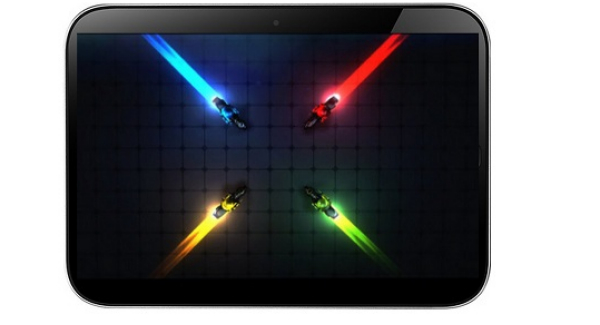After so many hands on experiences (both at MWC 2012 and local events), it’s finally time to review the much coveted ASUS PadFone, together with its PadFone Station tablet. Bundled, these two cost 699 euros and they’re already available in some part of Asia, but internationally clients have to wait a bit more for its arrival, due to the high demand for the Snapdragon S4 CPU. Anyway, let’s get to the review:
The idea is simple: you have a 4.3 inch phone that you insert inside a 10.1 inch tablet, that takes over the OS and hardware of the phone and uses it as its “brain”. They also share the camera, available on the tablet through a special hole in the special cover that protects the handset. In case you’re wondering, there’s also a keyboard dock out there, available for sale at a price of around 149 euros. Another interesting accessory is a stylus that also serves as a Bluetooth headset, but just like the keyboard dock, it wasn’t available for us to test. I must mention that the ASUS PadFone we had was a prototype unit, so benchmarks and general flaws aren’t relevant in this case.
Moving on to the design, I have to say I loved the teardrop shape of the PadFone, its metal frame and the texture of its plastic battery cover. The facade is completely glossy and glassy and it’s a nice touch, making the device look a bit more elegant. There are no physical keys on the front of the handset, so you only rely on the 3 virtual buttons from Android 4.0, like on the Galaxy Nexus. The PadFone has a microHDMI and microUSB port on one side, plus a small metal connector for the tablet and on the other side the volume buttons.
At the top we have the On/Off button and audio jack, while at the back there’s the camera with flash and under the hood we have the 1520 mAh battery, microSD card slot and SIM Card slot. Sadly, the battery won’t even get to a day of use, but once again this is a prototype, so it’s not very relevant. The ASUS PadFone measures 9.2 mm in thickness, weighs 129 grams, while the PadFone Station measures 13.5 mm in thickness and weighs 725 grams. Overall, the hybrid becomes heavy when the two are combined, being dangerously close to weighing a kilo, so it’s heavy on your hands and quite bulky.
The phone connects to the tablet through 3 connectors: the microHDMI port, the microUSB and a special metallic element on the side of the phone, all of these attached to “prongs” inside the tablet. Just close the lid and the 10 inch standard ASUS experience starts, exactly the same as on the ASUS Transformer Pad 300. Inside the PadFone you’ll find a Qualcomm Snapdragon S4 dual core processor at 1.5 GHz, with an Adreno 225 GPU. There’s also 1 GB of RAM, 16/32 GB of storage, plus an extra 32GB free ASUS Web storage for 3 years in the cloud.
Add to that microSD, WiFi, HSPA+ with 21 Mbps speed and GPS and you’ve got the full specs of the handset. The PadFone’s display is a 4.3 inch screen, with a 960 x 540 pixel resolution and based on Super AMOLED technology, plus Gorilla Glass protection. The PadFone Station has a 10.1 inch display with a 1280 x 800 pixel resolution and Gorilla protection as well. Inside the tablet there’s a 6600 mAh battery, that expands the phone’s battery 5 fold. With this combo you’ll get around 940 minutes of 2G talk time.
On the camera side, there’s an 8MP main camera on the phone/tablet, a front 0.3MP cam on the handset and a 1.3MP front cam on the tablet. The slate also comes with its very own phone and GPS antenna, for a signal boost. Speaking of which, the call quality is great, both on phone and tablet, that benefit from the same dialing app and great dialer interface. On the audio playback side, the handset gives out good volume, it has a nifty equalizer, while the tablet offers that SonicMaster audio technology and great volume as well.
Video playback also looks great and we’ve got a special outdoor mode for the display, giving it extra brightness. The camera was actually a pleasant surprise, since it takes very clear pictures, with vivid colors and does 1080p video capture. The camera UI is also unique for Android 4.0, requiring a swipe to trigger its options. We have a few effects, plus the usual white balance, exposure and other options. The rest is pure Android 4.0, with a bunch of unique ASUS widgets (phone/tablet battery widget, calendar widget, one click clean) and those connectivity and performance sliders at the top of the notification bar.
There’s also the section for ASUS settings, where you can trigger stuff such as taking screenshots by keeping the multitasking button pressed. One more thing to mention is the Pad Only apps section, situated between the Applications and Widgets area. This one will host the apps that you only want to run on the tablet, so if you fancy a game that requires a bigger screen, than you need it placed there. Overall, this is a very good product and its main appeal is the dynamic switch between the phone operation and tablet in just 2 seconds or so, even if you’re watching a video or browsing a website.
What we liked about this device are stuff such as design originality, its cloud storage, great CPU, fluid OS, surprisingly good camera and dynamic use. On the minus side we have the huge weight, low battery life of the phone, CPU delays and maybe the screen resolution of the phone. The ASUS PadFone and PadStation gets a 9 out of 10 from us in the design area, an 8 in hardware and a 9 in UI/OS. The total is 8.66 out of 10 for a very promising product, that might just become a world trend.
[youtube 1e7aB7YS4zk 660 520]
Post Footer automatically generated by Add Post Footer Plugin for wordpress.

















